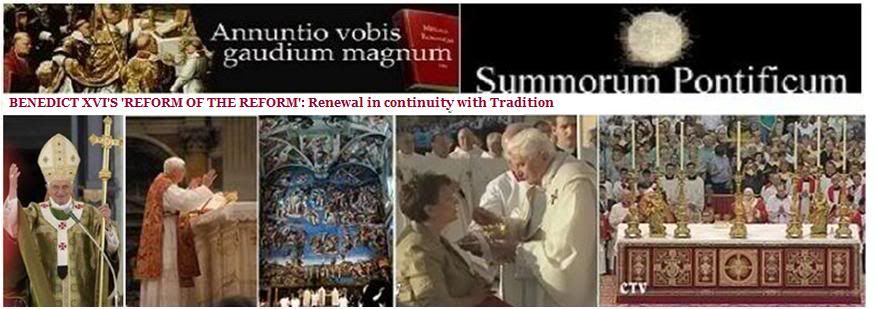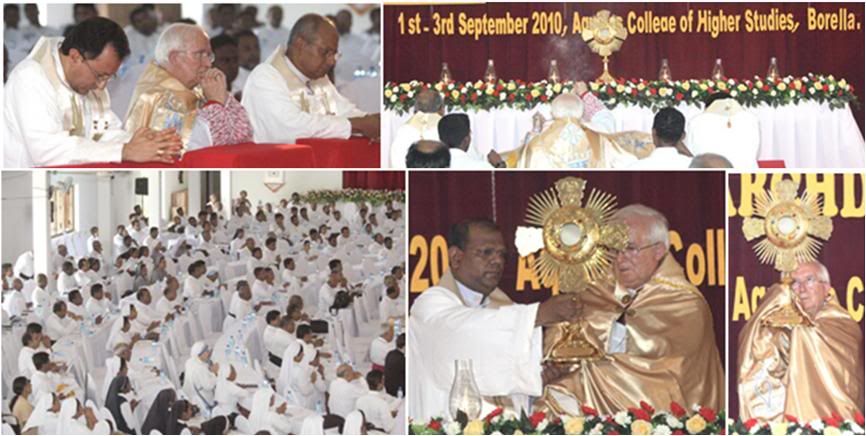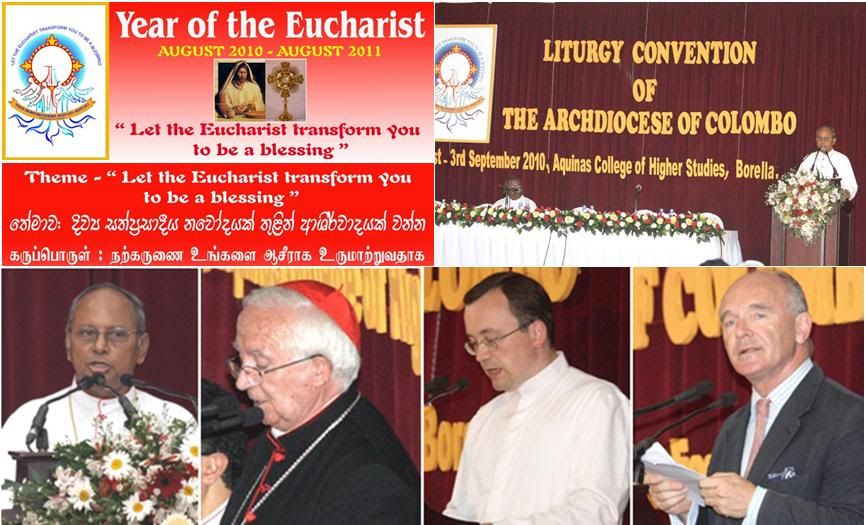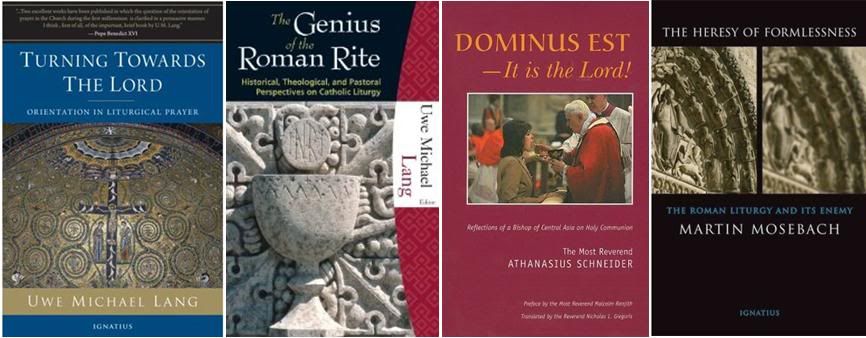 Benedict's best pupils in liturgy
Benedict's best pupils in liturgy
are in Sri Lanka and Kazakhstan
Bishops Ranjith and Schneider follow the Pope's liturgical example.
Which can't be said of most of their colleagues in Italy and Europe.

 Upper panel: Left, The Apostolic Nuncio to Colombo, Cardinal Canizares and Abp. Ranjith at Eucharistic Adoration. Bottom panel: Cardinal Canizares grants the Eucharistic Benediction.
Upper panel: Left, The Apostolic Nuncio to Colombo, Cardinal Canizares and Abp. Ranjith at Eucharistic Adoration. Bottom panel: Cardinal Canizares grants the Eucharistic Benediction.
ROME, October 14, 2010 – In Sri Lanka, the bishops and priests, all in white
[ which is the standard color for the clergy in tropical countries] of the diocese of Colombo, the capital, are shown listening to their archbishop, Malcolm Ranjith, who is likely to be made a cardinal at the next concistory.
In his diocese, Archbishop Ranjith has proclaimed a special year of the Eucharist. And to prepare for it, he gathered all of his priests for three days of intensive study last September on the liturgy in Colombo, where he brought in two outstanding speakers from Rome: Cardinal Antonio Cañizares Llovera, prefect of the Congregation for Divine Worship, and Fr. Uwe Michael Lang, a member of the same congregation and an adviser for the Office of Pontifical Liturgical Celebrations.
 Lower panel, from left: Abp. Ranjith, Cardinal Canizares, Fr. Lang and Martin Mosebach.
Lower panel, from left: Abp. Ranjith, Cardinal Canizares, Fr. Lang and Martin Mosebach.
Lang, German by birth and an Oratorian, was raised in Great Britain in the school of the great Henry Newman, who was beatified by Benedict XVI last September 19 in Birmingham. He is the author of one of the books that have provoked the most discussion in recent years, in the liturgical field:
Rivolti al Signore (Turning towards the Lord), in which he maintains that the correct orientation in liturgical prayer is toward Christ, for both the priests and the faithful. The book opens with a preface by Joseph Ratzinger, written shortly before his election as Pope.
Archbishop Ranjith, who before returning to Sri Lanka was secretary of the Congregation for Divine Worship, was and is an enthusiastic admirer and promoter of the thesis of Lang's book, as well as having the trust of Benedict XVI.
Just like Spanish Cardinal Cañizares Llovera, called not without reason "the little Ratzinger' in Spain, was called to Rome by the Pope to guide the Church in liturgical matters, a central concern of this pontificate.
Archbishop Ranjith also brought in from Germany a Catholic writer of the first rank, Martin Mosebach, author of a book that has also raised a great deal of discussion:
Eresia dell'informe. La liturgia romana e il suo nemico (Heresy of formlessness: Roman liturgy and its enemies). He asked him to speak precisely on the Church's disarray in the liturgical field.

All of this for what ultimate aim? Ranjith explained this in a pastoral letter to the diocese: to rekindle faith in the real presence of Christ in the Eucharist, and to teach how to express this faith in appropriate liturgical signs.
For example, by celebrating the Mass "facing the Lord," by receiving communion on the tongue instead of in the hand, and by kneeling to receive it. In short, with those actions that are distinctive features of the Masses celebrated by Papa Ratzinger.
The striking thing about this and other similar news is that Benedict XVI's work to restore vitality and dignity to the Catholic liturgy seems better understood and applied on the "outskirts" of the Church than in its European center of gravity.
It is no secret, for example, that Gregorian chant is today more vibrant and widespread in some countries of Africa and Asia than it is in Europe.
Among the guidelines given by Archbishop Ranjith for the Eucharistic year in the diocese of Colombo is, in fact, that of teaching the faithful to chant the Gloria, the Credo, the Sanctus, and the Agnus Dei in Latin at Mass.
In the same way, Benedict XVI's decision to liberalize the use of the ancient missal alongside the modern one – for a mutual enrichment of the two forms of celebration – seems to be understood and applied in Africa and Asia better than in some regions of Europe.
One proof of this concerns the way in which communion is given to the faithful: in the hand or on the tongue, standing or kneeling.
The example given by Benedict XVI – on the tongue, and kneeling – finds very few imitators above all in Europe, in Italy, and even in Rome, where almost everywhere communion is still given in the hand to anyone who approaches to receive it, in spite of the fact that
the liturgical norms permit this only in exceptional cases.
[I could never understand why an indult granted as an exception became 'universal' practice almost immediately as soon as the Novus Ordo was implemented.]
In Palermo, when the Pope was there last October 3, some of the local priests refused to get in line to receive communion from him, simply to avoid taking part in an action with which they do not agree.
[If we carry their absurd reasoning to the ultimate, would they refuse the Viaticum if they were unable to take the host into their hands and put it into their mouth? Why, in any case, would anyone prefer to get the Host into one's hands, pick it up with your fingers and pop it into your mouth? I suspect the real objection is to kneeling - which is one of the simplest and most beautiful acts of reverence one can perform before the Lord. But the mentality of many Vaticna-II 'spiritist's is that kneeling is an abjection that somehow 'offends' human dignity - as if anything one does to show reverence for the Lord could possibly be offensive. Oen does not kneel before the Pope or the priest giving communion - one kneels before the Eucharist!]
The canard is that people kneel for communion at Masses celebrated by Benedict XVI because they are before him, and not to adore Jesus in the most holy Sacrament
{There you go!] - even though other priests and bishops have been following the Pope's example for some time.
[Another absurd argument! What about all the saints in history who until 1970 knelt before ordinary priests to receive communion? No one ever thought before that kneeling to receive communion was kneeling for the priest and not for the Eucharist!]
Not suprisingly, the article that
www.chiesa dedicated in mid-September to the meaning of kneeling in adoration before God and the Eucharist raised protests from various readers, including some priests.
The main argument brought out against kneeling for communion is that the model and origin of the Mass is the Last Supper, where the apostles were seated and ate and drank with their hands.
[Because it was a regular Paschal meal, to begin with. The Last Supper became what it is for Christians now because the Lord instituted the Eucharist during that event. A symbolic recreation of it - which the Mass is - does not mean that all the gestures at the Last Supper should be recapitulated literally. Otherwise, the early Christians would have done that sitting around a table, and reclining as they ate, which was the custom in Jesus's time!]
It is the same argument adopted by the Neocatechumenals to justify their "convivial" way of celebrating the Mass and taking communion, to which they continue to adhere, although the Pope himself odereds them to stop that practice. 9And they have supporters in the Curia, like the deputy Secretary of State, Mons. Fernando Filoni).
[If the Neo-Catechumenals continue defying the Pope, someone should write an expose of it! Why should they be allowed to do as they please and not follow liturgical norms? And why isn't ayone writing about it?]
It is easier to go looking on the "outskirts" of the Church - as in Sri Lanka and remote Kazakhstan, a former Soviet republic in central Asia, than in Europe for parishes and priests who act and teach the liturgy in full harmony with Benedict XVI.
In the Kazakhstan diocese of Karaganda, the faithful receive communion on the tongue and kneeling. And the auxiliary bishop of Karaganda, Athanasius Schneider, has written a little gem of a book on the subject, entitled:
Dominus est – It Is the Lord! Reflections of a Bishop of Central Asia on Holy Communion.
The book is in two parts. The first recounts the heroic life of those Catholic women who during the years of Communist rule brought communion to the faithful in secret, defying the prohibitions. And the second explains the faith that was at the origin of that heroism: a faith in the real presence of Jesus in the Eucharist that was so strong that they were willing to die for it.
And it is against this background that Bishop Schneider revisits the Fathers of the Church and the history of the liturgy in the West and in the East, shedding light on the origin and reinforcement of this adoring manner of receiving communion kneeling and on the tongue.
When Papa Ratzinger read Bishop Schneider's manuscript in 2008, he immediately ordered the Libreria Editrice Vaticana to publish it. And it did, in Italian and Spanish.
Fittingly, the preface to the English edition was written by the archbishop of Colombo, Ranjith.
[Modificato da TERESA BENEDETTA 15/10/2010 15:39]